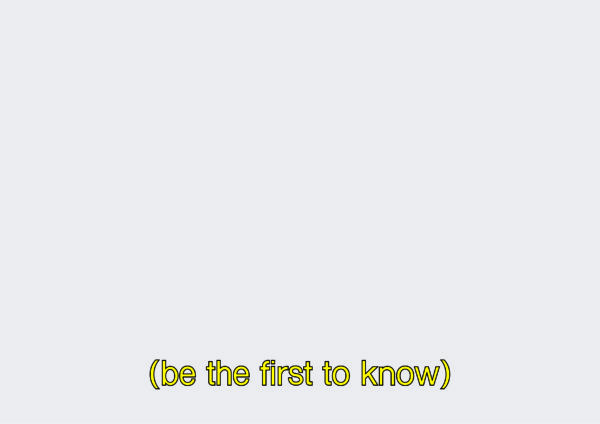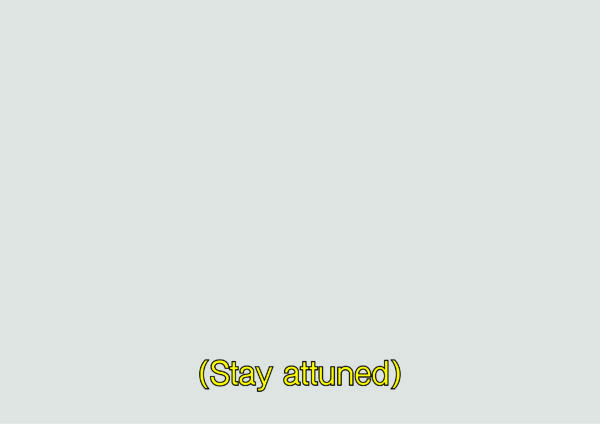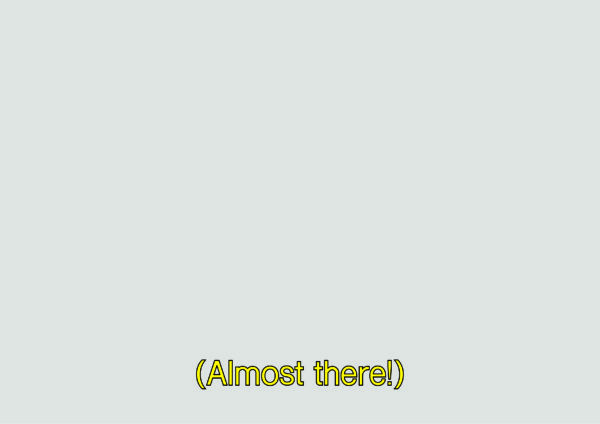It all started with an email, and given the ubiquity of work that has moved online over the past year, there can’t be a more fitting closing to the Our New Normal series – a closing which is simultaneously a cautious opening up towards the online.
On Sun, 31 Jan 2021 at 17:57, Maisa Imamović <maisaimamovic@gmail.com> wrote:
“Here I am, right on time. First of all, I'd like to thank you again for the invitation and confess that it has been a truly challenging one. Partly because I'm going through a digital fatigue and reflective semi-blockage, but that wouldn't have been a good reason to give in to this common experience and not push myself further.
Without further ado, you'll understand what I'm talking about through the text. I must admit that it took some time to know what to write about (especially since Alina summed up a great deal so beautifully). I'm an impulsive/intuitive writer, very much dependent on the moment of click. Everything I wrote in the text comes from a click that happened on Wednesday. I gave it the freedom to change all my writing plans for this opportunity, which also explains why I see this text as a raw, first draft.
Furthermore, I wrote this text intending to bring awareness to the core/technical structures of creative platforms from a web developer's, a writer's, and an artist's perspective. Web development indeed became a trend in the creative sector and we see many artists switching to the field for income purposes, which is quite understandable in times of crisis. It was one of the reasons why I became one myself, however, I am not entirely content with the general discussion about who an artist and who a web developer are, when compared in the same field. Furthermore, I wrote this text with an aim I'm still trying to fully understand.
As always, I want to keep the focus on the body, the user, the human, the worker. Who are you; what's the impact of new normal on the body?”
By Maisa Imamović
The camera is moving slowly in the direction of the writer who is sitting in a chair located on the main stage. He is holding a text, a bit of A4 printed matter. He is waiting for a closeup. He’s surrounded by darkness, a setting that makes it easy to assume the following moment will be accompanied by a switch of lights over his dark outline. The lights go on. The camera takes a deep breath and focuses sharply on his face. Then it moves down to capture the text’s title “Machines are learning cultural elitism.” The camera takes another breath and moves up to his face again, and freezes for exactly 5 seconds. This cinematic gesture alarms us that the writer has something to tell us.
Exactly 2 seconds after the freeze, his eyes roll down. He coughs a little, then starts to read:
There is a yet unpublished website to be deployed from the router of [insert_web_studio] located in [insert_Amsterdam]. The website’s development has been commissioned by the new [insert_institution_name] in town, which has, due to Corona’s harsh conditions, decided to speed up the process of establishing their core mission and instead proceed with prioritizing the strategies of being out there.
Pause pause pause. What we are about to read is a cinematic playout of a website with its current state under construction. There are three different stages where three different operational bodies are located and operating. All three are involved in the website’s buildup. The writer continues to read:
Up until now, they managed to gain some public attention through their Instagram account from which they posted several HQ stories fully functioning as trailers in order to excite the public pondering over what they’re about to become as an institutional body.
A decision to move their reputation to an official website is a logical one. Not only will it give them more authenticity and legitimacy, but it will turn their IG account into a different functional tool and that is: to catch the cultural users’ attention into checking out their new website. To clarify further, all IG posts will link to pretty much the same content on their official website, and indeed, with more visually pleasing effects. Before we proceed with the story, let’s take a moment to prepare thoughts about the equality of informational value on both online platforms (IG + website).
.
.
.
.
.
.
.
Switching to the website as the main tool for informational output is a lot of work. One of its main challenges is that of defining or redefining their institutional position with and for its people. A voice similar to that of a moderator would come in handy on this, but this voice is not usually counted in the default budget plan templates. Since an emerging [insert_institution_name] is also following the default template, the founders themselves decided to become moderators during the only meeting they planned for discussing what their core mission will be. That worked out well for them and led to an end of a successful meeting. Successful, in this case, means that they agreed on the core mission and no extra time shall be planned for solving this puzzle.
Our core mission is to maintain the importance of art production by featuring the best local artists, stimulating collaborations, and offering stylistic freedom of expression (through various skeletons of our soon to be website). All next meetings are planned for material preparation for the official website.
Unlike IG, the website must archive a delicately selected visual material of the happenings, in combination with thorough descriptive texts about each. Because documentation is (!) important, the official website will require more time and more expertise to select and curate the content which will fill up the web’s skeleton. When exposing content, [insert_institution_name] aims to have a unique style of doing so and that is: to not overexpose. To attain such a stylistic goal, the founders agreed to the following restrictions for the website:
-Access to the archive can only happen with creation of an account,
-except for open calls. Open calls must always be accessible and perhaps even be a landing page.
-Open calls must not reveal any budget, nor the institution’s desire to explore a certain [insert_topic]. Open calls strictly point arrows to the deadlines.
-Maximum number of archived images per event must be 5.
-Maximum number of words written per event description must be 300.
-Each happening must be titled with the date of its occurrence.
They believe that starting with these limitations will shape the mystery they very much need in order to attract a bit more audience. The mystery, they believe, will rush the artistic urge to fill up the missing web-skeletons provided by the institution. In a year from now, when the [insert_institution_name] clicks on the Archive button of their website, they dream of seeing the following:
...01/04/2021
02/04/2021
03/04/2021
05/04/2021
06/04/2021
07/04/2021
08/04/2021
09/04/2021
12/04/2021...
Every art materialized day in the calendar would guarantee governmental funding and prove their core mission right: that perpetuation of art shows the importance of art.
Avoiding getting too distracted with potential future achievements, the time has come to invest all their initial money in commissioning a web developer. Just like carefully selected content, deciding on who will deliver this part of the work must be done with extra care too. The web developer must be someone recognized in the cultural sector, aka someone with an affinity for art and who strives to see the continuous production of art. The web developer must be expensive, therefore trustworthy, and preferably someone who has an established network. Following such taste regimens is what brings them to [insert_web_studio], where only the best websites for clients in the creative sector are developed.
The [insert_web_studio] began their coding vision with a passionate ambition to revolutionize the traditional strategies of web development and change the production of generic trends. Their fascination roots in files that compile slow-websites, glitches, and navigation icons that look nothing like hamburger bars. So far, their coding experiments could only be conducted with creative clients and artists, who also believed the user to be a body with agency and not a passive consumer of information’s output. Therefore, having a good taste in information is a defining point to the studio’s uniqueness.
When the [insert_web_studio] received an offer from [insert_institution_name], the [insert_web_studio] had to think about it. The risk of accepting the offer could be that they might end up not liking their web-creation. Besides conflicting tastes, something else was at stake.
The writer looks up at the camera. Two seconds pass before the lights start fading out. The writer becomes an outline again. He gets up from the chair and leaves the main stage, conditioning the viewers to face the dark void. Another two seconds pass, and the camera, now accompanied by many other cameras, moves towards the backstage, where the actual [insert_web_studio] is located. The camera breathes out.
Graphic designer: I am skeptical about the institution’s digital start.
Front-end web developer: Me toooooo!
Back-end web developer: Same here.
*mutual silence*
Graphic designer: Without [insert_institution_name]’s own understanding of the amount, quality and necessity of their production, it’s hard for me to imagine the appropriate web stack and visuals to accompany it.
Front-end web developer: Unless a random shape.
Back-end web developer: You mean header, body with spontaneous images, footer?
*mutual silence*
Graphic designer: At the same time, we never got commissioned for such an urgent project before. Perhaps it is our responsibility to fill up the institution’s missing gaps through the website. Nailing this task might result in similar institutions asking for our attention in the future. We could be the designers of all digital, cultural starts.
Front-end web developer: It could be a trap.
Back-end web developer: By trap you mean that we will all end up being back-end web devs?
*mutual silence*
Graphic designer: Putting fears aside, I think we’re capable of stepping back, don’t you? I reckon that, once we nail this one, we get together to reflect together whether the service fits our original vision. Whether it slows it down, or accelerates it. Hardens, or softens it. Nourishes, or starves it. Waters, or dries it out. Pets, or punches it. Advances, or destroys it. How does that sound?
Front-end web developer: Where do we sign?
*a sound of signature plays loud in the background*
Graphic designer: Now, let’s start working. We have three months to realize the project, meaning no time shall be spent on experimenting and making creative decisions concerning the website’s navigation. To lessen the pain, think of header, footer and body dancing in harmony! The core mission of the website should be to make it fast enough for the users to generate content quickly. All styling will come along the build-up, and all styling decisions will be made on the spot and closer to the deadline. Let’s talk about the website’s skeleton.
Front-end web developer: There are seven pages:
0. Landing page: lists monthly open calls and has a register to apply button.
*Once registered*
1. Homepage: ‘newsfeed’ page which lists all available happenings that the logged-in user can follow; all of these are created/announced by the [insert_institution_name])
*The following pages are lists of happenings available for the user to follow*
2. Studio visits (talks with winning artists in their homes/studios) (max video length: 10min)
3. Virtual exhibitions (video tours of exhibitions set up by the winning artists) (max number of artists: 7; max video length: 10min)
4. Club-nights: Monthly live celebrations of [insert_institution_staff] + special DJ Set (max event length: 1h)
5. Open Calls: Announcements attracting artists and DJs to apply and be featured in studio visits, virtual exhibitions, and DJ sets. (max amount of words: 1200; max number of files: 1 pdf; max size: 1KB)
6. Vacancies:
- Tracking artist (tracks all interface changes made on the website and announces them with full creative freedom; no limitation of words/images)
-Performance artist (performs one of the staff members during Club-nights; full creative freedom, max event length: 1h)
Back-end web developer: Easy.
Graphic designer: Sounds great! Let’s keep in mind that we don’t want to end up sounding like Facebook, so let’s leave a free chunk of time closer to the deadline to apply suggestive language to the website’s void of information.
Front-end web developer: Cool.
Back-end web developer: Cool.
Sweat is fogging the office and all cameras are leaving the backstage. A blackout follows. Cameras go to sleep.
Six months later, cameras turn on again. Their next paid gig is to find an expert to update on how the situation evolved. The scene opens up with a user sitting in front of the screen. Her screen is showing a browser full of tabs. In the current tab, we see her logged in profile on the [insert_same_institution_name_like_the_one_ in_the_beginning]’s website. It looks like there is no history of activities:
>You are currently not going to any studio visits. How about [insert_artist_name]?
>You are also not going to any exhibition in the near future. Users from your surroundings are going to [insert_long_exhibtion_name]?
>Oh no, you have not applied to any open calls so far! How about this one on [insert_date]?
>You are currently unemployed. Content-tracking position is still available.
It turns out that this user has a professional role in society and she happens to be a well-paid media theorist. Today’s shift entails reviewing 7 new cultural platforms out loud and directly to the camera. After she has reviewed them, she needs to recommend one which could eventually be trusted by the audience. While analysing this page of inactivity history, she reports her doubts:
Each time my cursor hovers over a clickable object, a sensation cuts through me. Some sort of digital resistance numbs my clicking finger. Choosing has not always been so hard. Therefore, disinterest. Immense disinterest to click see more, expand, follow, subscribe.
Hence why I’m stuck on this page, staring at the void of my activities, materialized.
But that’s just how I feel.
Practically speaking, this platform functions by daily listing out new happenings + its content generated through open calls. An empty hole of possibility, their access strategy slash my opportunity, is what enables continuous production of new content thrown back at the user’s attention slash my attention.
That makes a whole lot of sense, but why is my attention dying? Why is everything looking the same? Even artist names are starting to sound repetitive. I can conclude here that information overload leads to fadeout of its importance slash its quality. My interest is starting to feel like work. My disinterest: unsupported. There’s not one clickable element that allows me to stay interested through my inactivity. (For instance, when you finish a book on Goodreads it asks you to rate it but it also gives you a No Rating option). When the void keeps talking back, it looks like a productive way is the only way to exist here.
We’ve indeed seen online platforms behave like this before, but I’m doubting about online cultural institutions. What is clearly at stake here is a new cultural elitism maintaining the status through the access strategy slash your opportunity. By offering access to different modes of production, cultural institutions insist that they’re practicing democratisation. By moving their hierarchy system to online realms, cultural institutions keep on claiming that what they're doing is creating communities welcoming different voices. Supposedly, Open Calls call all voices. However, I’m not entirely convinced that this strategy guarantees to maintain the importance of art, because information is not knowledge. Information is yet another digital platform like this one on my active tab linking to its Instagram profile, linking to its newsletter, linking to its Facebook page. The expanded digital presence of every cultural institution delivers the same message: We need you to need us, because we need their money.
There are, of course, exemplary institutions that are aware of these layers of production, and because of their awareness, they choose to operate otherwise. I very much hope to find them in the tabs awaiting.
At last, I’d like to end my remarks with a remark on technical delivery: Outstanding. Were it not for the website and its design, I would let my logged in session expire.
A smile follows. As the media theorist mentally travels in the direction of a context where her psyche nourishes itself in critically important ways, all hired forces accompany the camera to deliver the episode’s end. The ghost musician starts playing drums in the back, two assistants move the camera’s tripod backward, the other three jump to turn the lights off. Three, two, one, zero. The director’s hesitation to say “Cut” makes him physically awkward, and the awkwardness causes him to accidentally spill Club-Mate over the socket.

Maisa Imamović is an Amsterdam-based writer, designer, and web-developer who likes to draw. She graduated from Gerrit Rietveld’s Architectural Design department in 2018. She then pursued the Full-Stack Web Development certificate at BSSA. Her main research interests are ‘the island of boredom’, the impossibility to be bored, bodily restlessness and constant search for distraction. Maisa observes trends, cliches, conditions of honesty, and writes about them. As a designer, she doesn’t produce much in the physical. Through web-development, she is an observant of ways in which codes and user experience ethics program lifestyles and modes of being. Since 2019 she is a senior researcher at the Institute of Network Cultures (Amsterdam University of Applied Sciences). She was published in Kajet, Simulacrum, Forum, and runs her own blog at Living Industry.
 Our New Normal – het vervolg
Our New Normal – het vervolg
 Sisyphos is building a new city
Sisyphos is building a new city
 Aankondiging: Our New Normal
Aankondiging: Our New Normal
 To the sheeple
To the sheeple
 Shifting Paradigms
Shifting Paradigms















